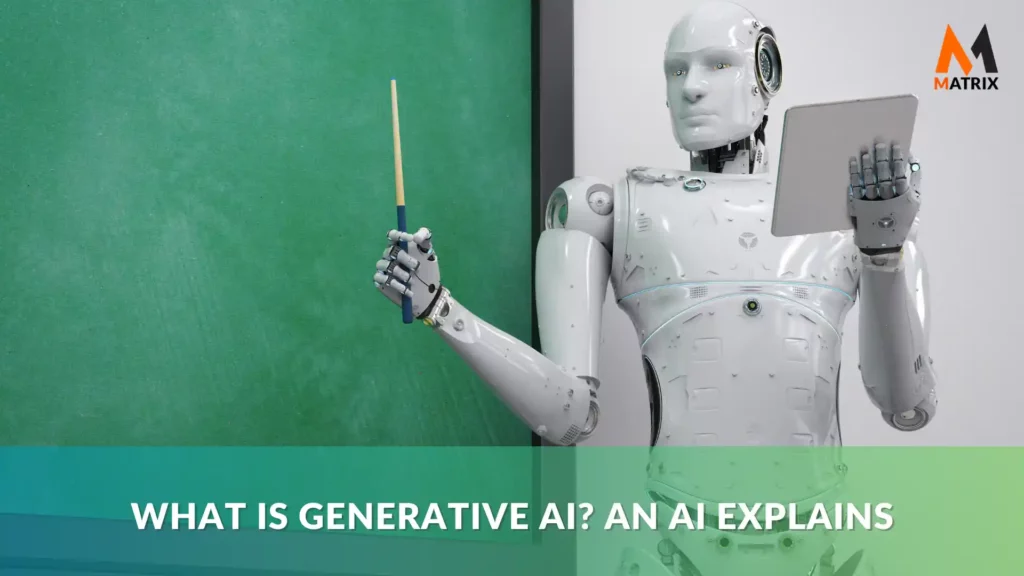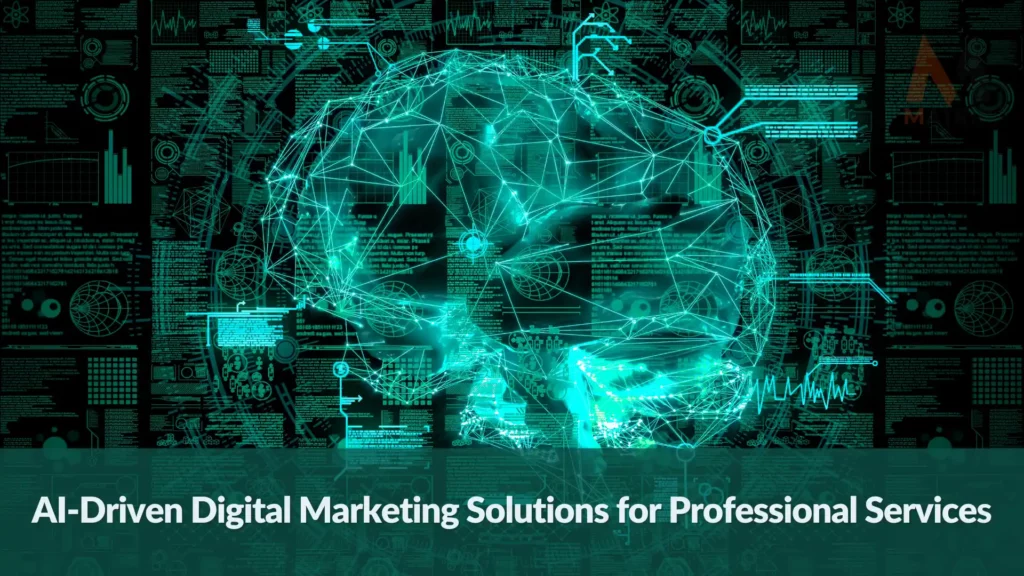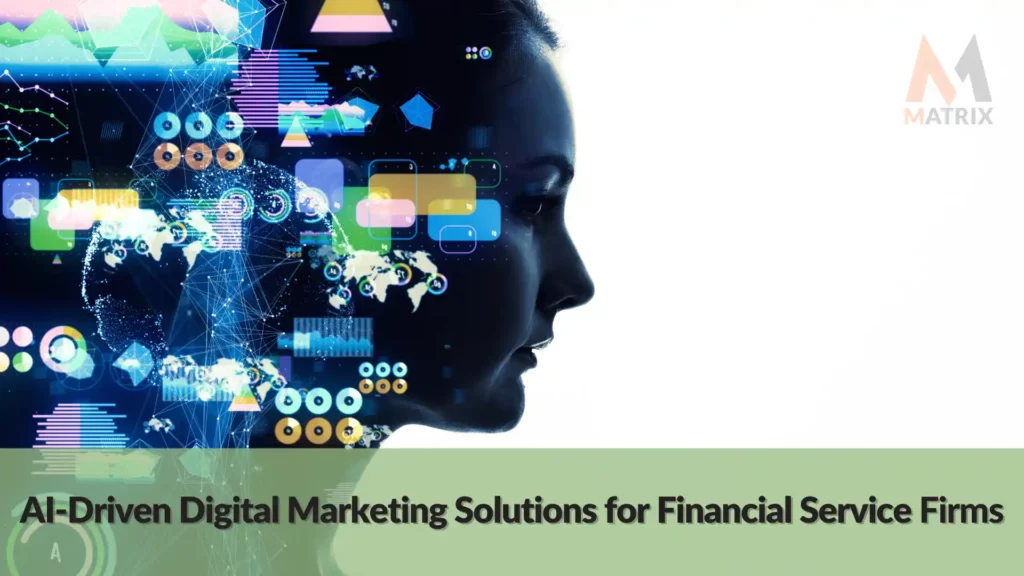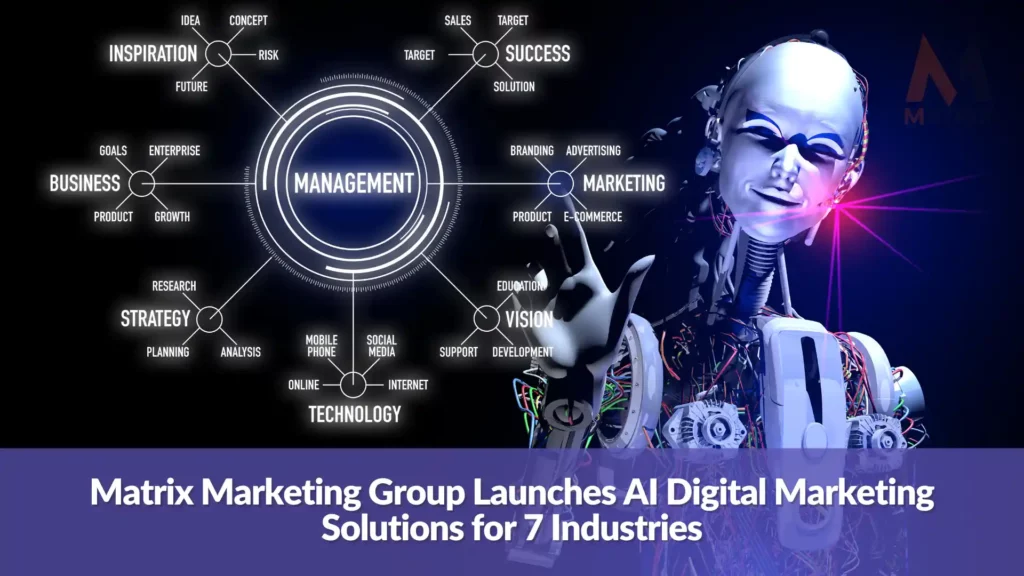What Is Generative AI? An AI Explains
Learn what generative AI is. An AI explains.
Are you a CEO wanting to know more about the AI revolution? You’re in the right place.
Generative Artificial Intelligence (GAI) is one of the latest technological advances that has transformed how businesses work, allowing for greater productivity and efficiency when managing processes and data.
But what is generative AI?
To shed some light on this subject, we tapped into our confident, trustworthy, data-driven digital assistant to uncover everything you need about AI.
Our AI walks us through how it works, from understanding training sets to creating ‘generations’ of deep learning models – let’s dive in!
I. Introduction
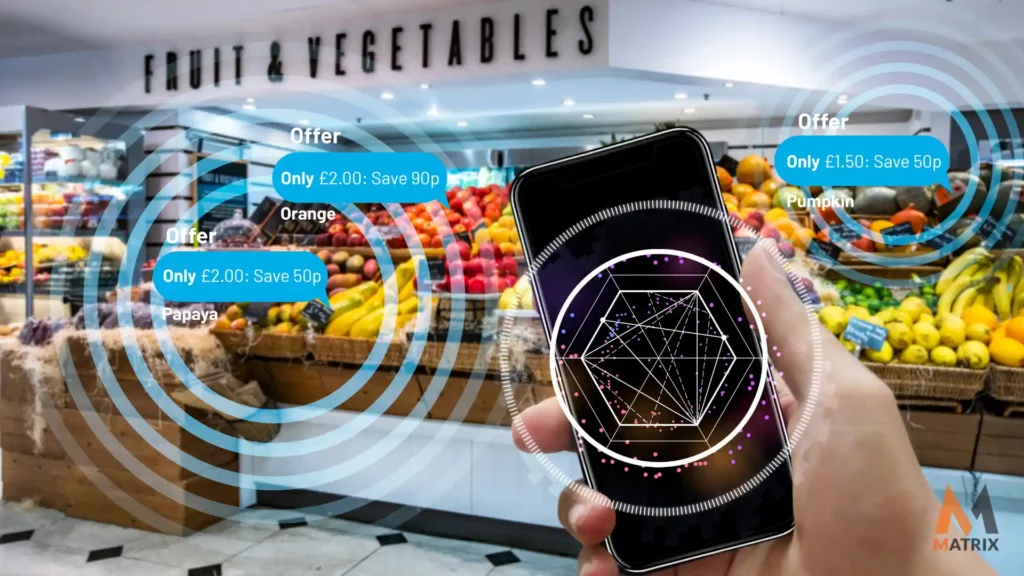
I remember, on Feb. 16, 2011, the final episode aired featuring IBM’s Watson against top champions Brad Rutter and Ken Jennings. It wasn’t even a contest — by the end of the third and concluding match, Watson was up nearly $50,000.
Watson had one, and something about it piqued my interest. So back in 2015, we decided to explore more affordable AI solutions and ran into OpenAI among Google Labs.
Now, we see AI applications with PaLM 2 and duet AI, and a NEW business operational purpose is accelerating. Modern AI in healthcare, manufacturing, marketing, sales, finance, education, technology, etc. It is more than spitting out generative AI text
Here’s what we know today.
A. Brief Explanation of Artificial Intelligence

Artificial Intelligence, or AI, is an emerging technology revolutionizing our world.
It is primarily concerned with creating intelligent machines that can perform tasks that would otherwise require human intelligence, such as speech recognition, decision-making, and language translation.
At its core, AI is based on creating software that can learn and adapt independently without any human intervention. This learning ability makes AI invaluable in various applications, from self-driving cars to medical diagnosis.
As we continue to push the boundaries of what is possible with AI, we can expect to see it become an even more integral part of our daily lives.
B. Introduction
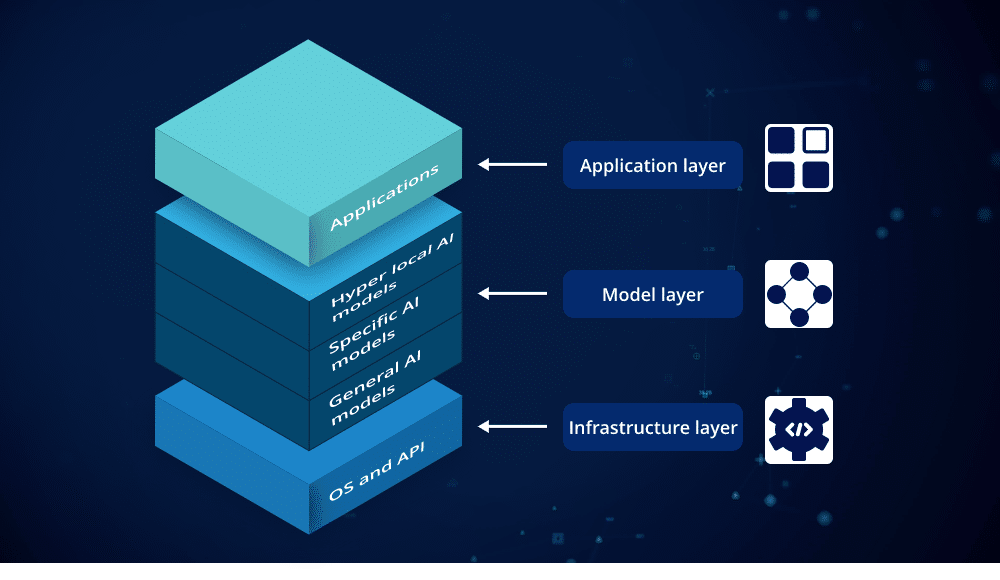
AI is a fascinating field of study rapidly gaining popularity within the tech industry.
This technology involves using artificial intelligence to generate content that can be used for various purposes, including but not limited to AI music, music composition, image generation, and even creative writing.
As our society increasingly relies on technology and AI’s capabilities continue to grow, it’s easy to see why deep learning models are such an exciting area of research. Experts predict that this technology will profoundly impact many aspects of our lives in the future.
So, suppose you’re interested in learning more about this cutting-edge technology and its potential applications. In that case, there’s no better time to dive in and explore the world of deep learning models.
II. Understanding Gen AI
GAI is a fascinating technology revolutionizing how we approach artificial intelligence. GAI is the ability of machines to create entirely new and original content that looks like a human created it.
The AI revolution is here. Are you capitalizing on it?
This includes everything from images, videos, and even messages that could be mistaken for something a person wrote. Understanding deep learning models requires a basic understanding of how the system works.
At its core, AI relies on neural networks modeled after the human brain’s biological structure. These networks are fed vast amounts of data and use this information to create something new.
What’s exciting about deep and machine learning models is that they can learn, meaning the outputs get better and better over time. With this technology still in its infancy, it’s fascinating to think about what it can achieve in the future.
A. Definition of Generative AI
GAI is a fascinating branch of artificial intelligence that has been making waves in the tech industry in recent years.
Productive AI essentially means creating new content or information using machine learning algorithms. This means that the AI is not just regurgitating information that it has been programmed with but is generating new content on its own.
This has exciting implications for industries such as music, art, and even journalism, where productive AI can help us create new and innovative work that we may never have thought otherwise.
While there are still many obstacles to overcome in this field, it’s clear that GAI is set to change how we think about creativity and innovation for years to come.
B. How Generative AI Works

GAI is a fascinating technology that utilizes algorithms to create new and original content.
Unlike traditional AI models, which are programmed to respond to specific prompts or inputs, productive AI can produce new outputs that weren’t explicitly programmed into the system. The key to its function lies in its ability to learn from patterns and trends within a specific dataset or language.
This means that model AI can produce unique pieces of content, such as poetry or music, without ever being exposed to them.
By analyzing vast amounts of data and learning from it, GAI has the potential to revolutionize a vast array of industries, from marketing and advertising to healthcare and manufacturing.
C. Differentiating Generative AI from other types of AI
As technology advances rapidly, Artificial Intelligence is becoming increasingly prevalent.
One subset of AI that has been gaining attention is AI. GAI’s ability to create original content rather than just learning from existing data sets it apart from other types of AI.
Generative AI musicians can generate new music, artwork, and even human speech. With its potential to revolutionize creative industries, the distinction between GAI and other types of AI is becoming more important to understand.
By recognizing its unique capabilities, we can better appreciate the innovation that it brings to the table.
With its clean, minimal design and powerful feature set, Frost enables agencies to build stylish and sophisticated WordPress websites.
III. Types of Generative Models
Generative models are a fascinating area of machine learning that allows computers to generate data similar to what they’ve previously seen.
There are several different generative models, each with strengths and weaknesses. For example, Variational Autoencoders (VAEs) are powerful models that efficiently generate complex data such as images.
At the same time, Generative Adversarial Networks (GANs) are particularly good at generating realistic images when trained on large amounts of data.
Other generative models include autoregressive, flow-based, and Boltzmann machines, each with a unique way of generating data. As generative models continue to improve, we expect to see them utilized in more and more applications, from art to robotics and beyond.
A. Overview of different generative models
Generative models are artificial intelligence (AI) models that can produce real data by learning from existing data. The traditional method of programming computers requires hard-coded rules for the computer to follow.
However, with generative models, these rules can be learned through machine learning techniques. Generative models can be categorized into several types of generative AI: autoencoders, generative adversarial networks (GANs), variational autoencoders (VAEs), and normalizing flow models.
Each type has strengths and weaknesses, and the choice of which type depends on the specific task. Generative models are widely used across different industries, including computer vision, natural language processing, finance, and music composition, to name a few.
With the rise of big data and advances in machine learning techniques, generative models are expected to become even more prevalent.
1. Generative Adversarial Networks (GANs)

Generative Adversarial Networks (GANs) are shaking up the world of artificial intelligence. This innovative technology consists of two neural networks working hand-in-hand to create new and realistic content, such as images and music.
One network generates a sample, while the other critiques its authenticity. Through this iterative process, GANs can continually create better content that looks and sounds closer to the real thing.
GANs are revolutionizing the way we think about AI and what it’s capable of. With the ability to create entirely new content seamlessly, who knows where GANs will take us in the future?
a. Explanation of GANs
If you’re familiar with deep learning, you may have heard of GANs or generative adversarial networks. But what exactly are they, and how do they work?
At their essence, GANs are a type of neural network that can generate new data based on training data. They work by having two networks — a generator and a discriminator — compete against each other to produce the most realistic output.
The generator tries to create new data that will fool the discriminator into thinking it is real, while the discriminator tries to distinguish between real and generated data. The result is a generator network capable of producing realistic new data that resembles the input data it was trained on.
It’s a fascinating field of research that has produced some truly remarkable results and will keep growing as more researchers explore its potential.
b. How GANs work
Generative Adversarial Networks (GANs) are one of the most exciting developments in artificial intelligence today. At a high level, GANs consist of two neural networks: a generator and a discriminator.
The generator uses complex mathematical functions to create new data, such as images or text. At the same time, the discriminator is trained to differentiate between these new examples and those from the original dataset.
As these two networks are pitted against each other in a constant back-and-forth battle, they learn and improve over time. The result is astonishingly lifelike images and other data that can fool even the most experienced human eyes.
By allowing machines to generate new information and learn from their errors, GANs are helping to push the boundaries of what we thought was possible in AI.
2. Variational Autoencoders (VAEs)
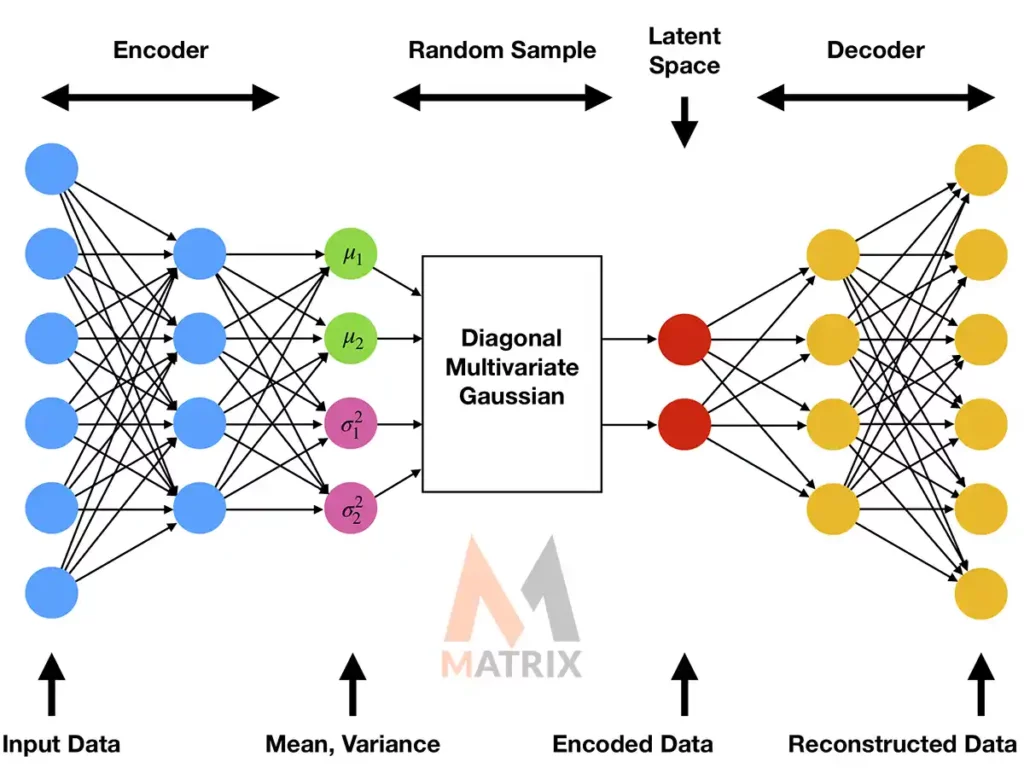
Variational Autoencoders or VAEs are the leading-edge tools used in artificial intelligence research and development to represent data.
They are designed to learn high-level representations of complex data, such as images, which can be used for various applications in fields such as medical, engineering, and aviation.
VAEs are powerful tools in understanding data, as they can learn a compact representation of a complex dataset that can be used for further processing. They can abstract and generalize the information, enabling it to generate new data beyond the scope of the original data.
With VAEs, researchers can train AI models to work smarter and more efficiently, ultimately driving innovation and progress.
a. Explanation of VAEs
Variational Autoencoders, or VAEs, are a type of artificial neural network that can create digital representations of complex data. These networks can recognize patterns and generate new examples of data similar to what they’ve memorized.
VAEs do this by encoding data into a latent space of probability distributions and then decoding them back into their original form.
This results in reconstructed data similar to but slightly different from the original, allowing VAEs to create new and unique outputs.
With this technology, applications like computer vision and natural language processing have been revolutionized, making VAEs one of the most exciting developments in artificial intelligence today.
b. How VAEs work
VAEs, or Variational Autoencoders, are a fascinating aspect of machine learning and artificial intelligence. They are used to create models that can generate new data based on patterns found in a given data set.
VAEs work by creating an encoder network that learns to compress input data into a lower-dimensional representation, which is then used to reconstruct the original input using a decoder network.
But what sets VAEs apart from other autoencoders is their ability to generate new data by sampling from the latent space of the encoder network. This process allows VAEs to generate new data similar to but not identical to the original data, opening up exciting possibilities for generating and designing new content.
With their versatile nature and potential for creative applications, understanding how VAEs work is crucial in exploring modern machine-learning techniques.
B. Comparing GANs and VAEs
Generative Adversarial Networks (GANs) and Variational Autoencoders (VAEs) are two of the most popular deep generative models in artificial intelligence.
While both models can generate new data by learning the underlying distribution of input data, there are some crucial differences between them. GANs use a two-part neural network to generate synthetic data by pitting two models against each other, while VAEs use a probabilistic approach to create new data.
Despite their differences, both models have proven effective in various applications, such as image and speech generation.
The choice between GANs and VAEs will ultimately depend on the specific application and data being used. However, understanding the differences between these two models is essential in selecting the appropriate architecture for a particular project.
IV. Applications of Generative AI
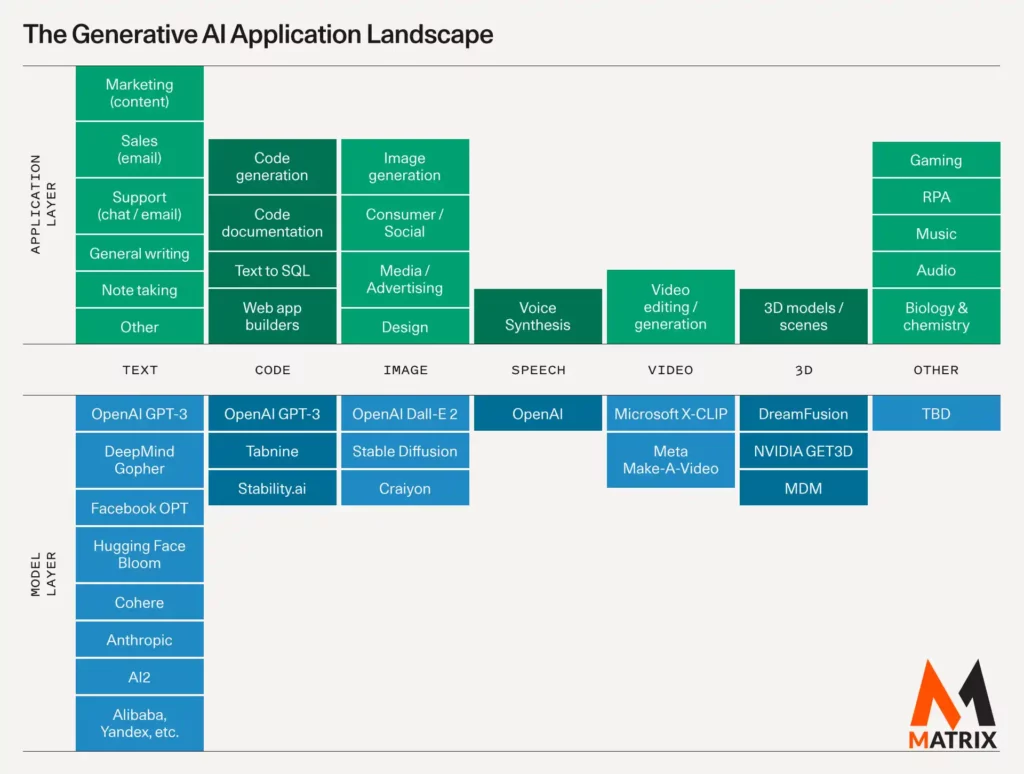
GAI can create new and original content that mimics human thinking and creativity. One of the most exciting applications of this technology is in language generation.
With GAI, it is possible to translate text from one language to another and generate new text that sounds like a native speaker wrote it. This has wide-ranging implications for content creation, journalism, and e-commerce industries.
Imagine reading articles written by AI that use natural language processing to convey complex ideas in a way that is easy to understand.
Or being able to shop online and receive product descriptions generated more persuasively and tailored to your tastes. The possibilities with GAI in language generation truly are endless.
A. Generating text

Generating text has become an integral part of our daily lives as technology continues to advance. It is now possible to effectively communicate with a machine, thanks to Natural Language Processing (NLP) techniques.
This includes speech recognition and understanding, language translation, and text generation. These advancements make the output language code a crucial element in generating text.
It ensures that the machine delivers the intended message in the right language and tone, regardless of the input language.
As more complex algorithms are developed to understand and interpret human language patterns, the future of text generation looks bright, opening up endless possibilities for effective communication across borders and cultures.
B. Creating images and artwork
Creating images and artwork is a wonderful way to express yourself through visuals. Whether you’re an aspiring artist or just looking for a creative outlet, there are countless ways to bring your ideas to life.
Some prefer to work with traditional mediums like pencils and paints, while others opt for digital tools such as tablets or graphics software. With so many options available, the only limit to what you can create is your imagination.
The process of creating artwork can also be therapeutic, helping to reduce stress and anxiety. So why not try it and see where your creativity takes you?
C. Composing music
Composing music is like creating a masterpiece with sound. It is a creative process where the different notes of a melody are pieced together to create a symphony that touches the soul.
Many famous composers like Beethoven and Mozart have given us timeless classics that continue to captivate listeners throughout generations. In today’s world, composing music is no longer just for the professionals.
With technological advancements, anyone can create their music right from their computer. Whether you want to write a hit song or express yourself musically, composing music is a rewarding experience that lets your creativity fly high.
D. Designing new molecules for drug discovery
Designing new molecules for drug discovery is an exciting research field with immense potential for improving healthcare worldwide.
Scientists and researchers constantly search for new ways to create molecules targeting specific diseases and disorders, from cancer to Alzheimer’s. This process has become faster and more efficient with technological advances and computational tools.
By designing new molecules, scientists hope to uncover powerful new treatments that can alleviate the suffering of millions of people around the world. The possibilities are endless, and the potential for impact is enormous.
E. Digital marketing

Digital marketing has revolutionized the way businesses connect with their target audience. With the rise of online platforms, social media, and various communication channels, digital marketing offers a plethora of opportunities for companies to reach out to their customers.
Businesses can showcase their products and services to a wider audience through paid advertising campaigns to engage social media posts. The beauty of digital marketing lies in its ability to target specific demographics and track user behavior, which allows companies to deliver personalized and relevant content to their audience.
As a result, businesses can establish their brand presence, generate leads, and increase conversions through a well-planned digital marketing strategy. Digital marketing is essential in today’s digital landscape and will also play an increasingly critical role in the future of businesses.
E. Other applications

As technology continues to evolve, it’s no surprise that innovative ways to use it keep popping up. From high-tech gadgets to advanced software, our daily lives are impacted in ways we never thought possible.
With that in mind, let’s explore some exciting applications for technology that you may not have considered. The endless possibilities are virtual reality, machine learning, or drone technology. Who knows what groundbreaking advances we’ll see shortly?
One thing is for sure, these technological advancements are changing the way we interact with the world around us and are helping us to tackle some of society’s biggest challenges.
V. Ethical and Privacy Considerations
Ethical and privacy considerations have become increasingly important in today’s digital age. With the vast amount of personal data being collected and stored, individuals must understand their rights and how their information is used.
This can be especially challenging for businesses and organizations that need to balance the need for data collection with the responsibility to protect user privacy.
With advancements in artificial intelligence and machine learning, there is the potential for biases and discrimination to be perpetuated through automated processes. Here at Matrix Marketing Group, we saw the opportunities years ago.
As society continues to rely on technology and data-driven decision-making, ethical and privacy considerations must remain at the forefront of our discussions and policies.
A. Data privacy issues

In today’s digital age, data privacy has become a hot topic of discussion. The amount of personal data shared online has also increased with the increasing use of technology. This has led to concerns about who can access this data and how it is used.
From social media platforms to online shopping sites, every online interaction has the potential to compromise our personal information. While data privacy issues may seem overwhelming, we must take steps to protect our personal information and demand transparency from the companies we entrust with our data.
It’s time to take control of our digital footprint and ensure that our data remains private and secure.
B. Potential misuse of generative AI models
The rapid advancements in GAI have left many in awe of the technology’s capabilities. However, with great power comes great responsibility, and some are worried about the potential misuse of AI.
The ability to AI/ML text, images, and even videos nearly indistinguishable from those created by humans can be used for nefarious purposes.
For example, it could create fake news, manipulate social media, or even enable cybercriminals to impersonate people or commit identity theft.
It’s important to acknowledge the risks and work toward designing systems that prevent malicious use of this technology.
We must be mindful of the potential harm that can be done with AI and take appropriate measures to ensure it’s used for the greater good.
C. Strategies for ethical use of Generative AI
As the use of GAI continues to grow, ensuring that this technology is used ethically and responsibly becomes increasingly important.
With the limitless potential for generating content, getting lost in the excitement of what can be created is easy. However, it’s crucial to remember that we must uphold ethical standards regarding the content being created.
Some strategies for the ethical use of AI include being transparent about this technology, setting guidelines and standards for what content is appropriate to generate, and ensuring that the generated content does not infringe upon any copyrights or licenses.
Following these guidelines ensures that AI is used to its fullest potential while remaining within ethical practice boundaries.
VI. Conclusion
AI and machine language learning are in their infancy as it becomes more available. However, buying ChatGTP or Bard does not make you a writer.
The applications in marketing are endless.
Reflecting on everything we have covered is important as we end our discussion. Throughout this analysis, we have delved into various aspects of the topic and explored it from different angles.
From examining the current trends to identifying the potential challenges, we have gained a deeper understanding of the subject matter. As with any discussion, many different viewpoints exist, but we have formed a more comprehensive picture by considering multiple perspectives.
As we close out our conversation, it is clear that there is still much to be learned and explored. However, the insights uncovered here will undoubtedly pave the way for discoveries and advancements in the future.
A. Current State of AI and Machine Learning Language
The world of AI is constantly evolving, and the current state of the technology is both impressive and exciting. With the ability to generate human-like writing, music, and even artwork, the possibilities for this technology are virtually limitless.
Though there is still much progress to be made, researchers and developers are exploring further ways to improve the capabilities of AI.
As more industries adopt this technology, we expect an even greater impact on our lives and work.
AI’s future is filled with endless possibilities, and it’s exciting to think about what this technology will be capable of.
B. Future possibilities and directions for AI
As our society increasingly relies on technology, the possibilities for AI continue to grow. AI models bring to life predictable at the speed of change.
One exciting direction is using AI to generate more personalized content, such as music tailored to a listener’s tastes or uniquely customized art. Another intriguing possibility is using AI to create more realistic simulations for training purposes, such as simulations for pilots or soldiers.
AI may help address environmental issues by generating simulations that can model and predict the effects of climate change. As AI advances, the possibilities for AI applications are virtually endless, potentially radically transforming how we live and work.
C. Matrix Marketing Group launch the first AI digital marketing agency with its MatrixAI platform.
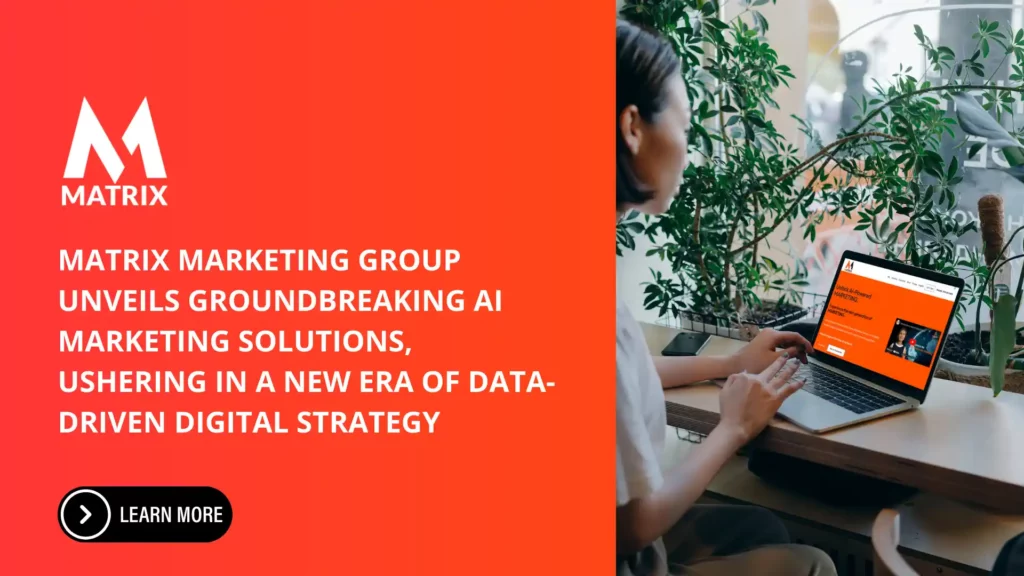
The marketing world constantly evolves, with new technologies and trends always emerging.
This is why the launch of Matrix Marketing Group’s MatrixAI platform is such an exciting development. Driven by proprietary generative AI algorithms, give us the generative AI tools to outperform competitors in seven key industries with generative AI use cases.
MatrixAI is supported by generative AI applications that work as blocks (foundational and operational) while other AI tools are snackable.
As the first AI digital marketing agency, MatrixAI is set to revolutionize how businesses approach their marketing strategies.
With its advanced artificial intelligence capabilities, the platform analyses vast amounts of data in real time, providing valuable insights and recommendations for optimizing marketing campaigns. This is not another ChatGTP add-on.
This means businesses can now benefit from a truly AI data-driven marketing approach, improving ROI and better customer engagement. With MatrixAI leading the charge, the future of marketing has never looked brighter.
General FAQs
What is Generative AI and how does Matrix Marketing Group utilize it?
GAI is a type of artificial intelligence that creates new content based on data it has been trained on. Matrix Marketing Group may use GAI in various ways, such as content creation, trend analysis, online advertising, and customer segmentation. This technology can generate marketing copy, suggest new marketing strategies based on past data, and identify key customer segments by analyzing patterns in consumer behavior.
How does GAI improve the services offered by Matrix Marketing Group?
GAI can enhance the services offered by Matrix Marketing Group by providing data-driven insights, automating content creation, and personalizing marketing strategies. It can help generate high-quality marketing materials quickly, identify new trends in the market, and tailor marketing campaigns to individual consumer preferences, thus leading to more effective and efficient marketing strategies.
What are the benefits of using Generative AI in marketing?
GAI offers several benefits in the marketing field. It can help quickly generate a vast amount of content, saving time and resources. It can analyze complex data sets to identify trends, consumer behaviors, and preferences, helping to create more effective marketing strategies. Additionally, it can personalize content and recommendations for individual consumers, enhancing customer engagement and satisfaction.
What measures does Matrix Marketing Group take to ensure data privacy when using Generative AI?
AI is playing an increasingly vital role in digital marketing for several reasons:
Personalization: to allow personalized marketing strategies to significantly increase customer engagement and conversion rates.
Predictive Analytics: predictive analytics is where future outcomes like customer behavior or market trends can be predicted, allowing businesses to be proactive and strategic in their marketing decisions.
Automation: GAI models can automate tasks such as email marketing, customer service responses, or content curation.
Improved Decision Making: AI algorithms can process and analyze large volumes of data quickly and accurately, providing marketers with valuable insights and helping them make data-driven decisions.
Customer Service: AI-powered chatbots and virtual assistants can provide 24/7 customer service, handling common queries and freeing human staff for more complex issues. This leads to improved customer satisfaction.
Content Generation: GAI text can create simple content such as social media posts, product descriptions, and articles, making production more efficient.
Ad Optimization: AI can optimize advertising by determining the best times, places, and formats to display ads to maximize return on investment.

